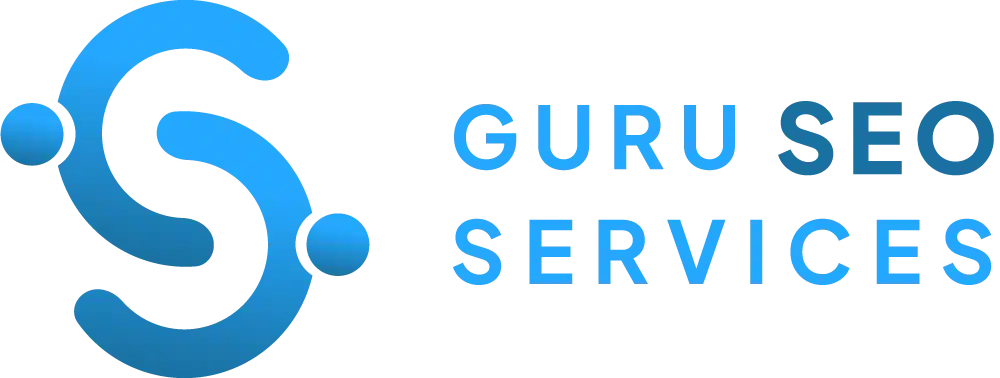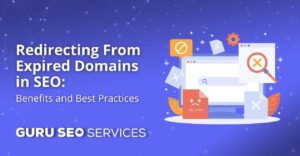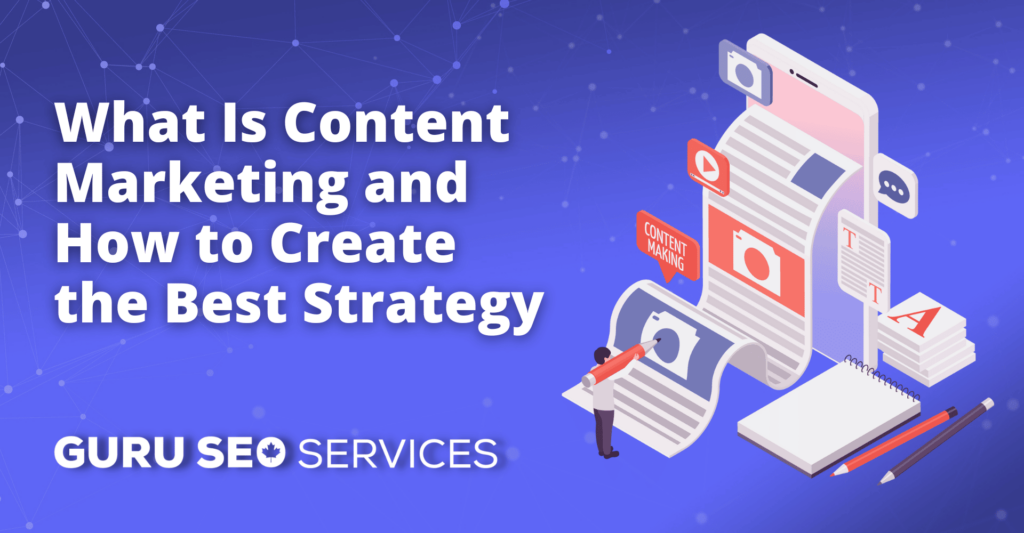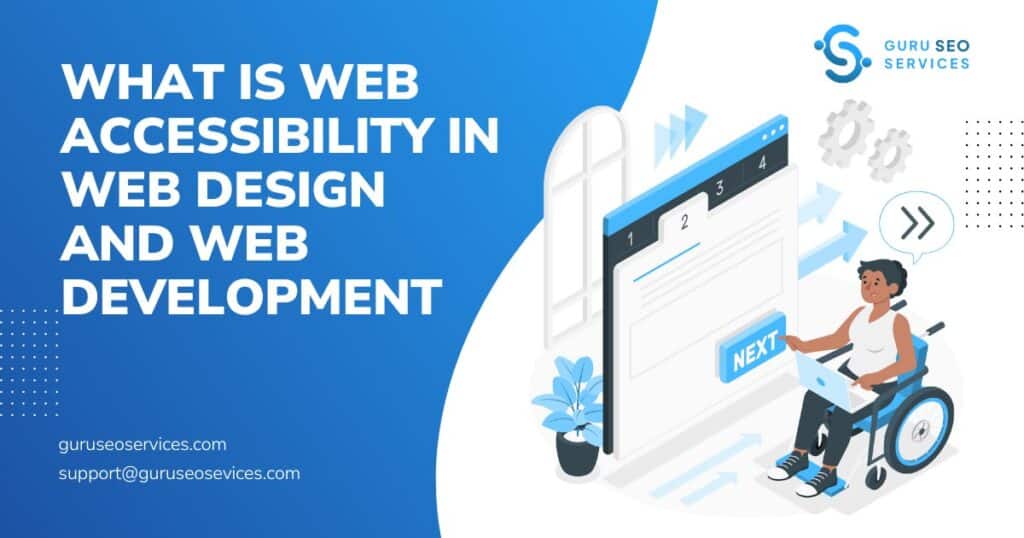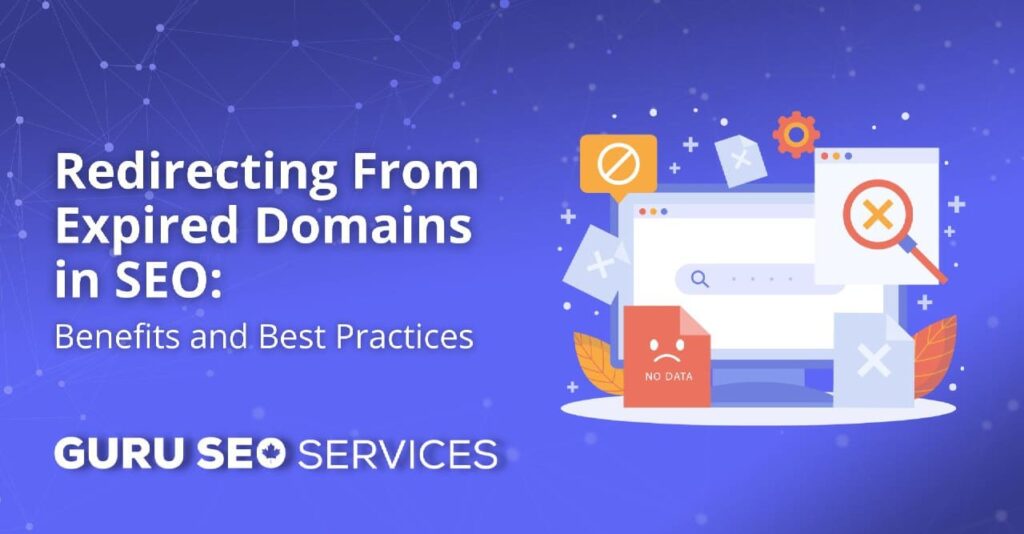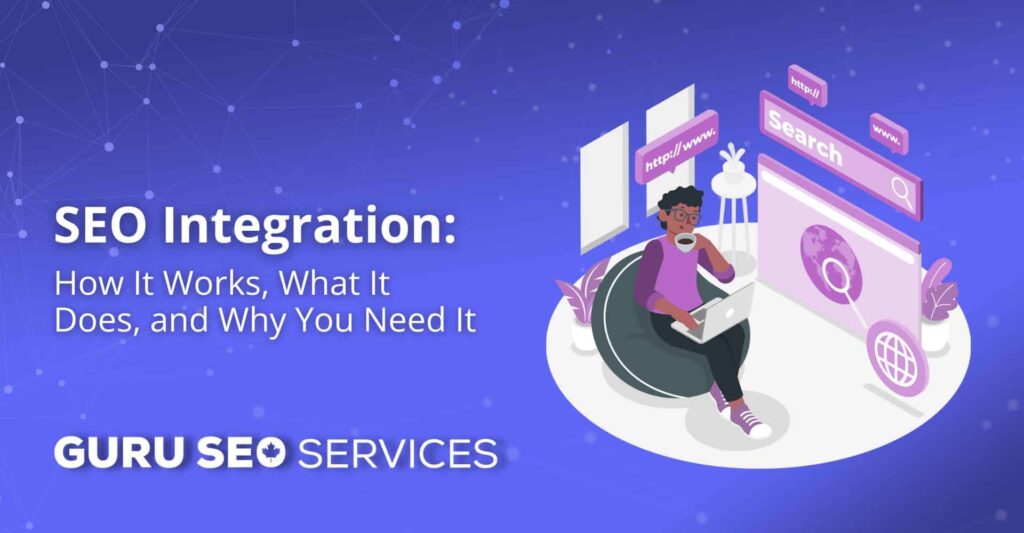What is content marketing and how exactly does it work? Can it really help my business and when can I expect to see results? Is content marketing something I can do on my own or should it be done by professionals?
If you’re looking for answers to these questions and more, Guru SEO Services is the best place to answer them. Today, we’re answering what is content marketing, the types to know, the strategies to do, and so much more. So let’s get right into it.
What Is Content Marketing?
First, the most important thing to do is to answer the question What is content marketing?
Content marketing is a marketing strategy that uses different tools and formats to accomplish many things. It helps with:
- Attracting, engaging, and retaining buyers and audiences
- Building trust
- Shortening sales cycles
This type of approach helps establish expertise, promotes brand awareness, and keeps a business in the customer’s mind.
Content marketing creates and distributes valuable, relevant, and consistent content to attract and acquire a clearly defined audience. The objective is to drive profitable customer action.
The most important factor here is value, and it’s what separates content marketing from almost all other types of advertising. The goal is to provide as much value from your content marketing strategy to as big a target audience as you can.
Why Is Content Marketing So Important?
Knowing what is content marketing doesn’t stop at just the definition and we’re sure you have more questions than answers. So before launching a full-blown strategy, let’s talk about why doing it is so important and what it can do for your business.
Better Rankings and More Organic Traffic
One of the biggest benefits of doing content marketing is that it helps a website rank higher in search engines. The higher rank is thanks to the keywords and phrases buyers use during the research process.
But the key to improving rank is being able to tap into the questions your audience is asking. If you do that, your website will be able to generate more organic traffic, as well as better-qualified leads.
To put it in simpler terms, the best content marketing strategy will obsess over answering every question the buyers are asking. Especially the tough ones. Business websites usually cover five key topics, which is a great start. These include:
- Cost and pricing
- Solving problems
- Comparisons and versus
- Best of lists
- Reviews
Once you have the base, you can then begin refining your content around specific keyword research using specialty tools.
Better Conversions and More Leads
One way to build trust with your audience is by creating high-quality and evergreen content, like articles and pillar pages. These should answer your readers’ questions and help them solve a problem. Once you help them do that, they’ll be more inclined to become customers, and not just remain readers.
That’s because a potential new audience will see you as a helpful resource and someone who actually cares. You’ll no longer be just a brand in the online space that’s looking to get money. People will feel more comfortable with your brand and what it stands for. That will give them more incentive to fill out forms on your site, which will lead to better conversions.
Increased Engagement
Most influencers and marketing managers will tell you that to succeed, you need lots of views and clicks. And that’s not far from the truth, but there’s much more to it.
While you want people to click on your content, you also want them to interact with it. Ideally, they’ll leave a comment on a blog or flip through more than one page once they get to your website.
That’s why having high-quality content will keep people on your site longer and keep them engaged. That’s not only important for your brand-customer relationships but also for search engines. All of these factors and more are what will determine your rank.
Shorter Buyer Journeys
A bit later we’ll dive deeper into buyer journeys and sales cycles, but you should know that great content marketing will help you shorten them. It can help leads become more qualified and educated, which in turn makes them more likely to close faster.
Another way to shorten a buyer’s journey is to create sales enablement content. It’s a type of content specifically designed to close more deals for your sales team.
With assignment selling, which is another content marketing strategy, sales reps can use educational content to answer questions and resolve the concerns of potential buyers.
Higher ROI and Lower Overall Costs
We can’t answer the question of what is content marketing without talking about return on investment (ROI) and the impact it has. Compared to more traditional marketing methods, content marketing costs about 62% less.
That’s because, in content marketing, businesses can take advantage of low-cost or no-cost tools like social media, Search Engine Optimization (SEO), and blogging. Even though paying someone to make the most out of these tools might seem like a significant upfront investment, it’s one that can pay dividends in the future.
Types of Content Marketing
Now that you know the definition of what is content marketing and why it’s important, it’s time to look at the types you might need or want to use. There are so many types out there, that it would simply be impossible to cover them all.
So let’s focus on the most popular types of content marketing and the ones that might make the biggest impact.
Online Content Marketing
Online content marketing is often used as an umbrella term to describe any time of content a business or brand publishes online to boost brand identity, attract customers, and search engine rankings.
But to be more specific, online content marketing refers to content that’s published on the business website to achieve any of these goals. The content might include standalone information pages, articles, or more.
Social Media Content
According to Kepios, in 2022, around 4.72 billion people used social media, equating to 59.3% of the world population. Many social media platforms can be used as distribution channels for content.
Even if you have the best content in the world, there’s no guarantee that your target audience will find it. Luckily, these distribution channels can help bring your audience closer to you and vice versa. Most content can be distributed either organically, which means businesses aren’t paying for anything, or via paid advertising.
Infographics
Infographics are an excellent visual medium that helps break down complex information and they’re meant to be shareable and enlightening. They can include statistics, charts, graphs, and other types of information.
Blogs
Even though marketers have many arrows in their quip to create their strategy, one thing most never go without are blogs. A frequently updated and helpful blog that is SEO-friendly is a marketing staple for good reason.
Blogs are one of the most powerful forms of inbound marketing that work wonders for SERP (Search Engine Results Page) and web traffic. There is an endless amount of potential in them and a near-endless way to use them to your advantage. Blogs can express brand identity, help build trust with customers, empower a site’s internal and external link structure, and more.
Podcasts
Many people prefer to consume content by listening to it, which is why brands are opting to create podcasts as part of their strategy. Podcasts can allow for free conversation between company leaders or feature interesting guests relevant to the industry.
Just the fact that more than 60 million people listen to podcasts across different platforms shows you what a potentially large target audience you can have access to. They also allow businesses to have creative control over how customers see their brand.
Videos
Video marketing usage is definitely on the rise, and for good reason, too. According to Wyzowl’s research, 89% of people say that watching a video has convinced them to buy a product or service. What’s more, a whopping 91% of people surveyed say that they want to see more online videos from brands in 2023.
One of the reasons video is so popular is that it’s such an easy way to consume content. Videos can also be educational, fun, and informative, and there are no limits to what you can do with them.
Paid Advertising
With paid advertising, brands can reach a broad audience and position themselves in places they want to be seen. They’re especially beneficial when paired with inbound marketing and there are lots of places to share them. Some companies opt to do paid advertising on social media, landing pages, banners or sponsored content.
Email Marketing
Email marketing has one of the best ROI in the digital marketing space and that’s because it allows for precise segmentation and predictable results. Using varied formats, like relational, promotional, and transactional emails, email marketing can accomplish lots of objectives.
One type of email marketing is a newsletter, which is used to disseminate news about the company, and share stories, or promotional opportunities.
How Content Marketing Works – The Buyer’s Journey
In our quest to answer What is content marketing, we have to talk about the buyer’s journey. It’s one of the key pieces of the puzzle that can be improved with content marketing. Here are what the typical stages of a buyer’s journey or sales cycle look like and what opportunities they present.
Awareness/Discovery Stage
In the awareness or discovery stage, content should focus on the top concerns of the target audience. Businesses should write about their customer’s pain points, challenges, or questions that have the highest chance of being engaged with.
At this stage in the journey, content should be educational or how-to advice. The selling isn’t taking place here, so businesses should save their tactics for the closing phases.
The best content for this stage usually includes blogs, articles, videos, newsletters, and even e-books.
Consideration Stage
Next up, there’s the consideration stage where consumers/customers start considering ways to resolve their issues. Content that it’s in the middle of the funnel helps prospects choose which solution is the best one for their specific problem. It’s also the moment when they’re weighing out all their options.
At this point, audiences and customers are more aware of the possible solution to their problems, which means they’re more informed. However, they’re still learning more about each and every solution and need help deciding which one would work best.
The consideration stage is also the moment where you, as a business, have to answer the question What’s the difference between… You could do a comparison of products, explain their benefits and advantages, and so on. Make your content informative and do it in a way that your potential customers will want to consider your brand to solve their problems.
Decision-Making Stage
The final stage is the decision-making or purchasing one, and it’s where the content helps prospects decide which company to purchase from. The type of content we usually see in this stage includes reviews, demos, case studies, customer journeys, and testimonials.
The bottom-of-the-funnel content can also include what it feels like to be a customer of the business.
How to Create a Content Marketing Strategy
When it comes to answering the question of what is content marketing, another big piece of the puzzle is going to be the strategy. Here are some good practices to implement in yours when starting your marketing journey.
Create the Buyer Persona
Earlier on, we talked about the importance of getting your content in front of the right audience. One way to do that is by creating a buyer persona for your business. It represents a character with all the attributes of your target audience.
When creating a buyer persona, you should think about who they are, what they want, and what they need to be solved. You should also consider their interests and history, and try to base it on real people that have bought from your company.
The concept of a buyer persona is more segmented than the one of a target audience. That’s because you can trace all the potential problems your persona has and compare them with what you have to offer.
Having a buyer persona at the forefront of your strategy will help you create content that answers their doubts. At the same time, it will help you create a bond and build a relationship between your brand and the audience.
Set Goals and KPIs
Once you have your persona, the next step toward answering the question of what is content marketing is the objectives of the strategy. The goals you set and the metrics you use are what will verify if your campaign is doing what it’s supposed to.
Some common goals we see in content marketing can include:
- Increase in traffic
- Increase in sales
- Generating more leads
- Spreading brand awareness
- Engaging the audience
Once you know the goals for your business, you can define the indicators to measure them. These are what are known as Key Performance Indicators or KPIs.
For example, if your objective is to have an increase in traffic, make sure to regularly check your website’s traffic. If your goal is to increase brand awareness, make sure to monitor social media interactions on all platforms.
Set a Budget
Marketing and advertising can cost a pretty penny, no matter if you’re doing it by yourself or decide to hire professionals. That’s why it’s important to set a budget and have a figure in mind before you start the process.
Now, there’s no set amount you should or shouldn’t spend on content marketing because every business is unique. With that said, the average company will allocate around 25%–30% toward its marketing budget.
One thing that’ll impact how much you’ll need is the type of content you want to do and who’s doing it. Some content tends to be more expensive, so if you’re working with a tight budget, stick with a few options for a while.
Of course, how much you spend will also depend on who’s doing it. Just remember, no matter what your budget is, you get what you pay for and that quality should always be above quantity.
Do Your Research
Earlier on, when talking about the benefits of content marketing, we mentioned how it can improve your SERP ranking. But to do that, you’d first need to appear on those pages using relevant keywords.
You have to research which keywords your audience writes about and try to rank for those. There are longtail keywords and short-tail keywords, and the former are more difficult to use but they are easier to rank for.
There are tools to help with basic keyword research, but they won’t help you create the right clusters. The only way to do that is by getting help from professionals in marketing, like Guru SEO Services.
Implement SEO
We’re going to assume that because you’re asking What is content marketing, you might not be that well-versed in best SEO practices. And that’s totally okay.
First, let’s break down Search Engine Optimization, which is essentially a set of techniques used to reach first place on search engine pages, like Google.
The higher you rank on Google, the better your visibility is and there’s a better chance of potential customers closing a deal with you. To achieve this, all your content needs to be optimized in a way to deliver a good experience to your readers.
There are so many SEO practices out there to keep in mind that it could get pretty challenging to do it by yourself. But if you need help, you can call Guru SEO Services and ask about our SEO processes to help you reach the top of Google searches.
Diversify Content Distribution Channels
More often than not, you can’t only pick one distribution channel for your content if you want coverage. Instead, you’re going to have to promote it with blogs, social media, or email marketing.
That way, your potential audience will have access to your content, no matter if they’re searching for it actively or passively.
Measure Results
Without measuring, analyzing, and remeasuring your results, you’ll get nowhere – and fast. Once you have your strategy in place, consider how and when you’re going to be collecting the results, and what you’ll be looking for.
Now, every business is different, so there’s no one-size-fits-all solution for collecting this data, just as there’s no one answer to the question of what is content marketing. With that said, you can first try measuring and analyzing data once a month, and then adjust as needed.
You should pick a few key metrics that you’ll be closely watching every week to ensure your strategy is on track. These could be but aren’t limited to:
- Email subscriptions
- Page views
- Conversion rates
- Web traffic
- Social media metrics (follows, likes, mentions)
Content Marketing Best Practices
Now that we’ve answered the question of what is content marketing and how to build a strategy, let’s take a look at some good practices.
For one, always make sure that your strategy is clear, carefully defined, and thought out. Then, make sure that it’s diligently followed. Remember, no content marketing success just happens by chance.
You should also research your keywords frequently and thoroughly to ensure you’re answering the right questions. The keywords you choose, whether low or high-volume, will be at the center of any digital marketing campaign. What’s more, monitoring the keywords on a regular basis, and looking out for things like click and search volume, and ranking competition is crucial.
Another important tip when it comes to learning about and knowing what is content marketing is to always have your audience in mind. You can never lose sight of who you’re trying to help with your products or services. Also, always plan content with user intent and your buyer persona in mind.
What Is Content Marketing – FAQ
Q1: What is content marketing?
A1: Content marketing is a strategic process that enables businesses and brands to build valuable relationships with their audiences through various types of media. It’s a way to drive more traffic and conversions from audiences by answering their questions and concerns.
Q2: How are content marketing and SEO different?
A2: While these two terms are often mixed up, they do very different things. Content marketing encompasses a broad strategy that targets and engages with users across various channels. On the other hand, SEO is a practice that helps make content more accessible and effective.
Q3: Does my business need a content marketing strategy and where can I get one?
A3: The short answer is – yes, your business needs a content marketing strategy. Without one, you’d essentially be shooting in the dark when it comes to your marketing efforts. You would have no way of measuring results and spotting opportunities to improve.
Of course, to accomplish the goals you want, your content marketing strategy needs to be precise, effective, and well-thought-out. The only way to achieve that is to have it done by professionals like Guru SEO Services.
In our agency, we know all the best practices to get your content and business in front of the right audience. Not only that, but we have the right tools to ensure your business makes the right impression.
If you want to know more about what we can do for you, schedule a free digital marketing assessment today!
